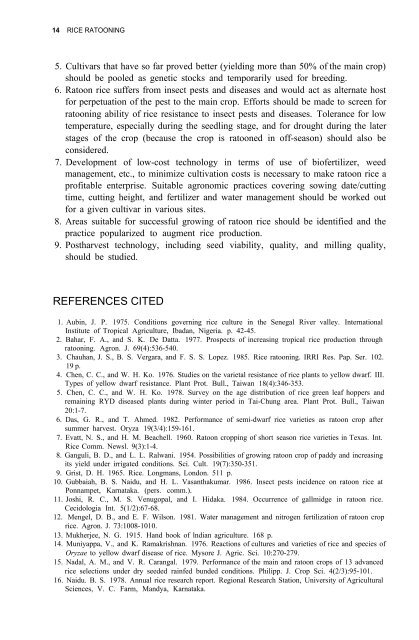RICE RATOONING - IRRI books - International Rice Research Institute
RICE RATOONING - IRRI books - International Rice Research Institute
RICE RATOONING - IRRI books - International Rice Research Institute
You also want an ePaper? Increase the reach of your titles
YUMPU automatically turns print PDFs into web optimized ePapers that Google loves.
14 <strong>RICE</strong> <strong>RATOONING</strong>5. Cultivars that have so far proved better (yielding more than 50% of the main crop)should be pooled as genetic stocks and temporarily used for breeding.6. Ratoon rice suffers from insect pests and diseases and would act as alternate hostfor perpetuation of the pest to the main crop. Efforts should be made to screen forratooning ability of rice resistance to insect pests and diseases. Tolerance for lowtemperature, especially during the seedling stage, and for drought during the laterstages of the crop (because the crop is ratooned in off-season) should also beconsidered.7. Development of low-cost technology in terms of use of biofertilizer, weedmanagement, etc., to minimize cultivation costs is necessary to make ratoon rice aprofitable enterprise. Suitable agronomic practices covering sowing date/cuttingtime, cutting height, and fertilizer and water management should be worked outfor a given cultivar in various sites.8. Areas suitable for successful growing of ratoon rice should be identified and thepractice popularized to augment rice production.9. Postharvest technology, including seed viability, quality, and milling quality,should be studied.REFERENCES CITED1. Aubin, J. P. 1975. Conditions governing rice culture in the Senegal River valley. <strong>International</strong><strong>Institute</strong> of Tropical Agriculture, Ibadan, Nigeria. p. 42-45.2. Bahar, F. A., and S. K. De Datta. 1977. Prospects of increasing tropical rice production throughratooning. Agron. J. 69(4):536-540.3. Chauhan, J. S., B. S. Vergara, and F. S. S. Lopez. 1985. <strong>Rice</strong> ratooning. <strong>IRRI</strong> Res. Pap. Ser. 102.19 p.4. Chen, C. C., and W. H. Ko. 1976. Studies on the varietal resistance of rice plants to yellow dwarf. III.Types of yellow dwarf resistance. Plant Prot. Bull., Taiwan 18(4):346-353.5. Chen, C. C., and W. H. Ko. 1978. Survey on the age distribution of rice green leaf hoppers andremaining RYD diseased plants during winter period in Tai-Chung area. Plant Prot. Bull., Taiwan20:1-7.6. Das, G. R., and T. Ahmed. 1982. Performance of semi-dwarf rice varieties as ratoon crop aftersummer harvest. Oryza 19(3/4):159-161.7. Evatt, N. S., and H. M. Beachell. 1960. Ratoon cropping of short season rice varieties in Texas. Int.<strong>Rice</strong> Comm. Newsl. 9(3):1-4.8. Ganguli, B. D., and L. L. Ralwani. 1954. Possibilities of growing ratoon crop of paddy and increasingits yield under irrigated conditions. Sci. Cult. 19(7):350-351.9. Grist, D. H. 1965. <strong>Rice</strong>. Longmans, London. 511 p.10. Gubbaiah, B. S. Naidu, and H. L. Vasanthakumar. 1986. Insect pests incidence on ratoon rice atPonnampet, Karnataka. (pers. comm.).11. Joshi, R. C., M. S. Venugopal, and I. Hidaka. 1984. Occurrence of gallmidge in ratoon rice.Cecidologia Int. 5(1/2):67-68.12. Mengel, D. B., and E. F. Wilson. 1981. Water management and nitrogen fertilization of ratoon croprice. Agron. J. 73:1008-1010.13. Mukherjee, N. G. 1915. Hand book of lndian agriculture. 168 p.14. Muniyappa, V., and K. Ramakrishnan. 1976. Reactions of cultures and varieties of rice and species ofOryzae to yellow dwarf disease of rice. Mysore J. Agric. Sci. 10:270-279.15. Nadal, A. M., and V. R. Carangal. 1979. Performance of the main and ratoon crops of 13 advancedrice selections under dry seeded rainfed bunded conditions. Philipp. J. Crop Sci. 4(2/3):95-101.16. Naidu. B. S. 1978. Annual rice research report. Regional <strong>Research</strong> Station, University of AgriculturalSciences, V. C. Farm, Mandya, Karnataka.

















